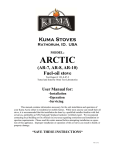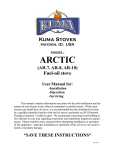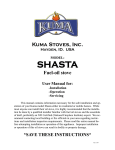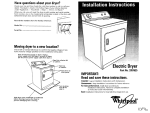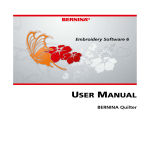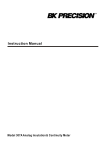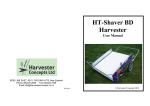Download Click to see the Kuma Oil Classic Owners Manual
Transcript
Kuma Stoves Hayden, ID. USA MODEL: OIL CLASSIC (OC-7, OC-8, OC-10) Fuel-oil stove User Manual for: -Installation -Operation -Servicing This manual contains information necessary for the safe installation and operation of your Kuma Oil Classic either in residential or mobile homes. While most anyone can install their oil stove, it is recommended that the installation be done by a qualified installer familiar with fuel oil stoves, preferably an NFI Certified (National Fireplace Institute) expert. We recommend contacting local building or fire officials in your area regarding restrictions and installation inspection requirements. Please read this entire manual before attempting installation or operation of this appliance. Improper installation or operation of this oil stove can result in bodily or property damage. *SAVE THESE INSTRUCTIONS* Rev. 3/07 1 CONTENTS Section 1– Stove placement, air requirements, and clearances….. pg. 1-2 2– The flue and flue connections………………………… pg. 2-3 3– Fuel tank installation and fuel line connections………. pg. 3-4 4– Lighting, adjustments to carburetor, and draft stabilizer adjustments………………………………. pg. 4-7 5– Servicing…………………………………………….. pg. 7-8 6– Trouble-shooting guide……………………………..... pg. 8-10 7– Warranty……………………………………………… pg. 10 SECTION 1 Stove placement, air requirements, and clearances Try to pick a location that will be somewhat central in the house or room in which you wish to install the Oil Classic. Due consideration of the fuel tank location, ease of fuel line installation, and flue location is wise. You will want to read the fuel tank section to get a better idea of where to locate the tank as well as the stove. The stove must be placed on hearth that is non-combustible, having a thickness of 3/8” or greater. A 36”x 36” hearth pad area is recommended. Once a location is established, the stove can be placed on the hearth and leveled. It is absolutely imperative that your Oil Classic is level. There are adjustment bolts under each corner of the pedestal base should these adjustments be necessary. Place a level on top of the pedestal base both directions and adjust until level. This unit has been tested to U.L. 307A and is approved for installation and use in manufactured homes. There are some special considerations when installing into a mobile or manufactured home. For model OC-10 (10” burner), the flue system must consist of a 6” diameter CLASS “A”, U.L. HT103 type insulated chimney, and a double-wall stove pipe connector. For models OC-7 and OC-8 (7” and 8” burner), a 4”, 5”, or 6”diameter chimney may be used, but must be Class “A” insulated chimney or approved 4” diameter Class “L” (pellet vent) chimney. Dura-Vent D.V.L. double-wall connector with a Dura-Vent # 8680 double-wall adapter is required or 4” diameter Class “L” vent may be used as a connector. The manufactured homeinstallation also requires an outside combustion air source. If outside air is accessed through the floor, a 4” diameter or larger duct should be installed through the hearth and floor, extending past the insulation barrier on the underneath side of the home. Make sure there is a rodent screen with a maximum 1/4” x 1/4” opening placed over the duct opening to prevent rodents from accessing the stove bottom. 2 The air duct does not need to connect directly to the stove as the duct may terminate at the hearth top level. If air is accessed through the wall, remove the air cover at the stove pedestal back, and install a 4” or larger duct connecting the stove pedestal and the wall. A storm or dryer type vent with a screen is adequate. For your convenience, an outside air kit (part # 4OAVK) is available through your dealer. All mobile home installations require use of OCHM1 Manufactured Home Kit which includes an automatic oil valve shut-off control rod, return spring, and all fasteners. Complete mobile home kit installation instructions are included with this kit. For further help or questions, contact your dealer. If you are not installing this stove in a mobile home, and outside air is not desired, simply remove the outside air cover at the pedestal back so ambient room air can enter. Please note that at certain draft conditions (i.e. high winds) a significant amount of air may be needed to achieve a proper burn. Consideration of open windows or an air source near the stove will probably be necessary depending on the “air-tightness” of your home. Again, outside air to your oil stove is a good idea as it will make the combustion impervious to house pressure problems. *Please note that these clearances are minimums. It is a good idea to exceed these clearances unless space is limited. Common sense must prevail. Minimum Clearances to Combustibles Sides Back Flue Pipe Corner Top Standard 8” 6” 9”* 4” — Alcove 8” 6” 9” 4” 54” Note: Corner clearance applies only when the stove is installed in a room corner with the stove placed perpendicular to the corner (45 degrees). Note: On alcove installations, the maximum depth of the alcove is 30”. *Clearances to flue pipe are for single-wall connectors. A double-wall connector is required for mobile home installations. SECTION 2 The flue and flue connections Do not connect this unit to a flue servicing another appliance. It is of utmost importance that the flue be dedicated to the Oil Classic as the flue is, without a doubt, the most important component of the system. Good combustion is dependent upon the correct amount of air being supplied to the burner at all times, which is dependent upon a correct negative flue pressure. Draft is caused by the gases inside the flue being hotter and lighter than the air outside, thus the rising heated gases carry out the products of combustion. Since the flue “sucks” gases up the flue, it is this suction that draws air into the pedestal area to feed the burn pot with the air needed for an efficient, blue-flame burn. (continued…) 3 This will depend on the flue’s ability to provide a consistent negative pressure. There is no substitute for a warm, efficient chimney/pipe system. If the flue gases cool too quickly, draft will slow and combustion will not be as efficient. Do not skimp on the flue system. A good rule of thumb on chimney height is a minimum of 12’ from the stove top to termination. Location of chimney and other factors may require more or less chimney height. In areas of high winds or draft inversions, a suitable wind-directional or vacuum cap may be needed. An insulated chimney is a must in order to maintain the heat inside the chimney for proper flow of gases. For model OC-10, use a class “A”, 6” diameter, all-fuel insulated chimney that has been tested to U.L. HT103 when passing through combustibles. For models OC-7 and OC-8, a 4”, 5”, or 6” diameter Class “A” insulated chimney or an approved 4” diameter Class “L” (pellet vent) chimney is approved. As a general rule, smaller diameter flues are better for draft and efficiency. The stove pipe connector may be single-wall black pipe with tight fitting joints (mobile home connectors must be double-wall, see Section 1), and must be securely fastened at all joints with 3 sheet metal screws. Fasten connector pipe to the flue collar on the stove and the ceiling box/wall thimble with screws as well. The Oil Classic may also be connected to a masonry chimney, but it is recommended that it be lined with a stainless steel liner and insulated as well. Use and install all piping according to the manufacturers listed clearances. Certain atmospheric conditions such as high winds will cause a change (increase) in the negative pressure inside the flue and thus inside the stove. To compensate for this, your stove has a draft or flue stabilizer which is a barometric damper located at the rear back of your stove. Upon installation of the stove and after lighting and warm-up, the rear cover must be removed and the draft stabilizer adjusted. Its purpose is to allow more or less air to travel into the flue to compensate for a change in the flue draft. Adjustment of the draft stabilizer will be discussed in Section 4. SECTION 3 Fuel tank installation and fuel line connections OIL: Your Kuma Oil Classic comes with a carburetor set for an average of a 2.35 cc. viscosity rating. You should be able to burn either #1 or #2 fuel with adjustments to the carburetor. Bio-diesel may also be successfully burned in the Oil Classic. Due consideration to fuel grades should be noted. #1 Fuel oil, K-1, or kerosene will burn much cleaner than #2 fuel and requires less maintenance. #2 fuel or diesel grades of fuel are fine to burn, however there are combustibles present in # 2 fuel that become solids when they are burned, thereby requiring more frequent cleaning of the decoker and burner. TANK: The fuel tank should be clean (second-hand tanks not recommended), so a new tank is advised. Steel tanks require more maintenance such as painting to prevent rust. A polyethylene tank is preferred as it will never rot or rust, and is basically maintenance-free. A tank with a larger capacity will require less fillings as well as an opportunity to obtain better pricing for fuel oil in greater quantities. Avoid placing the tank in direct sunlight. Warm tanks will condense moisture which will fall to the bottom of your tank where it will need to be drained to prevent valve damage and/or freezing and stopping oil flow. Also, due consideration should be given to accessibility to the tank for delivery trucks. The ideal tank should have two bottom-end outlets: one for fuel supply to the stove, and one to drain off any water and dirt. To be able to do this, the tank must be installed with a “fall” of at least 1/4” per foot of tank length. The fuel supply will come from the high end of the tank and the lower end will be used for draining condensation and impurities. If the tank has only one outlet, be sure to tip the tank away from the outlet slightly, as described above. Brick or cement foundation for the tank is advised. 4 To provide correct pressure of the fuel supply to your stove, the tank outlet should be between 16” and 72” above the carburetor on the stove. Do not exceed 72” above the carburetor as excessive head pressure could limit the carburetor’s ability to shut off fuel flow. Be sure the support system under the tank is safe and adequate as a full 300 gallon tank will weigh about 2000 lb. If you must install a tank below the stove, or above the recommended height, a lift pump and/or a level control valve must be fitted. You will need to check local building codes regarding such installations. CONNECTIONS: There should be 2 valves on a typical installation: 1) a shut-off valve at the tank to allow service to any piping, or changing the main filter and 2) a shut-off valve close to the stove to be able to isolate the stove for any maintenance, and (if required by code) a fire valve right before the fuel pipe enters the building which would automatically shut off the oil supply in the unlikely event of the stove overheating. Piping to the stove from the tank may be either steel or copper, but copper is preferred to prevent any rusting problems. When making the fuel line connection with the copper line from the tank to the stove, it is best to have a gradual slope or “fall” on the line (i.e. no dips or kinks) so as to prevent any air bubbles or collection of dirt or other impurities. A 3/8” diameter copper supply line is recommended and either compression type or flare type fitting may be used. Finally, a good quality filter that also traps water should be placed at the tank to ensure a good, clean supply of oil to your stove. The carburetor on the stove is equipped with a screen-type filter but it is not intended for use as the primary filter. SECTION 4 Lighting, carburetor adjustments, and draft stabilizer adjustments PRE-LIGHTING CHECKS: The installation should be inspected to ensure that the work is complete and the workmanship is satisfactory. No stove should be lit if any part of the installation does not comply with the relevant standards and regulations. The oil tank should be examined to confirm there is a supply of the correct grade of oil, that a filter and a working isolation valve are fitted. Having verified that the oil pipe work up to the stove is complete and that the fire valve (if used) is closed, the tank isolation valve should be opened and the pipe work inspected for leaks. The pipe into the inlet of the metering valve should be uncoupled, the shut off valve opened and a minimum of one quart of oil collected into a suitable receptacle. If dirt or water is present in this sample, additional oil should be allowed through the pipe work until it is free from contaminates. The fuel pipe work should be reassembled and all connections checked for leaks and tightened as necessary. For 7” Burner Models: Laying on top of the catalyst inside your Oil Classic 7” burner model stove is a stainless steel top burn ring. It is important that the ring be in the proper position. It comes in the proper position from the factory. Should the height of this ring change, it is easy to re-adjust by bending the three tabs that rest on the catalyst top up or down. It is very important that the “cupped” part of the ring is facing up (as if it would hold water). The stove will not burn properly if the ring is face down. Locate the two continuous rows of air holes circling the burner top. The top ring tabs should set on the catalyst top so that the outer edge of the ring comes out right between those two rows of air holes. LIGHTING: Initial lighting should be undertaken by a qualified technician, with a suitable probetype manometer for checking the flue pressure. Although adjusting the draft stabilizer by “feel” 5 is possible, the most efficient method of tuning the stove is at the start and with the proper equipment. The customer who will be operating the stove is an important partner in this process, so a full understanding of how the stove operates and is maintained is invaluable. Shortly after the stove is lit an air pressure reading should be taken. To take this reading, drill a hole suitable for the manometer probe size in the stove pipe directly above the stove outlet. After pressure readings are finished, simply plug the stove pipe hole with a suitable sized screw. Lighting the stove: 1. Remove the catalyst (stainless steel mesh cylinder) from the burn pot. 2. Turn all supply valves on. 3. Turn control knob on carburetor to setting 1. 4. Press on/off control lever on carburetor to start (it pulls up and clicks to shut stove off and pushes or clicks down to on position). 5. When a small amount of oil begins to appear in the burner bottom, take a wooden kitchen match and light the oil (a small piece of crumpled tissue paper can be lit and tossed into the burner if desired, or use an alcohol-gel fire starter). 6. When oil is lit, replace the catalyst and shut the door (a slightly cracked door is helpful for a short period of time to aid initial light-up of oil, but should not be required for more than 30 or so seconds). Until the flue pipe warms up and draft is initiated, your Oil Classic will burn with a high, yellow/ orange flame. This is normal during start-up. It is simply burning off excess liquid oil that accumulates in the burner bottom before the catalyst turns red and begins to vaporize the fuel. 7. Within a few minutes, the stove burner should begin burning blue at flame base and yellow at flame tip. At this point a pressure check should be made, and the draft stabilizer adjusted to within the recommended pressure setting range (see draft pressure chart on page 7). 8. Run the stove for at least 30 minutes on low or medium to allow the whole stove and chimney to come up to operation temperature. 9. Turn the control knob to setting 1 and run for about 10-15 minutes and check the pressure once again. 10. You are now ready to adjust or “tune” your Oil Classic according to the following carburetor adjustment section. CARBURETOR ADJUSTMENTS: Your Oil Classic has a carburetor that has both low-fire (setting 1) and high-fire (setting 6) adjustment screws on the top. They are small slotted screws that are of red color and may need to be adjusted for correct flame size. Both low- and high-fire settings have been pre-set at the factory, but depending on your choice of fuel (#1 or #2 grade), these will usually need to be adjusted for the viscosity of fuel you are using. Please note that after initial warm-up, it is important to adjust the high flame first, then the low flame as any adjustments made to the high can affect the low, but not viceversa. Below is a description of what the flame should look like at both low– and high-fire: Low-fire: The flame should be totally blue with blue flame “spears” or jets dancing between the inner wall of the burn pot and the catalyst. The catalyst will be dull red to bright red. There will be blue flame appearing around the fire ring at the burner top. You can decrease the setting to where there is only the blue spears in the burn pot and little activity of blue flame at the burner top. However, if there is any yellow flame in the burn pot on low setting, then the low-fire adjustment screw needs to be increased to a total blue flame condition. 6 High-fire: The flame should be bright yellow with a 2/3 fire-box height to where the flame will begin to break up and terminate just a few inches under the firebrick baffle. The base of the flame at the burner ring should still be blue, and the catalyst will be a dull red. If the flame is too high and allowed to impinge on the firebrick baffle too much, the result will be a cooling of the flame tip, and incomplete combustion, thereby producing smoke and soot. Adjust the high-fire adjustment screw to achieve proper flame size. *EACH ADJUSTMENT OF NO MORE THAN ONE-QUARTER TURN SHOULD BE ALLOWED TO STABILIZE FOR FIVE MINUTES BEFORE MAKING ANY FURTHER ADJUSTMENTS ON EITHER HIGH– OR LOW-FIRE. *MAKE SURE THE FLUE PRESSURE IS CORRECT BEFORE MAKING ANY CARBURETOR ADJUSTMENTS. The carburetor on your Oil Classic has a main float valve internally to regulate the oil level in the stove. It also has a separate, second safety float that can trip off if the oil level becomes too high in the carburetor. Should this occur, you can reset the safety lever by clicking it back down to start. You may need to reset the lever several times before the level of oil in the carburetor returns to a normal level. Your Oil Classic has been rigorously tested to both U.L. 896 and U.L. 307A for both residential and mobile homes, and should the fire snuff out for any reason, the carburetor will not allow more than 3/4” of oil in the bottom of the burner. IT IS IMPERATIVE THAT THE STOVE IS BURNING PROPERLY AS EXPLAINED ABOVE. A POOR DRAFT OR POORLY ADJUSTED STOVE COULD CAUSE THE STOVE TO SOOT AND BUILD UP GASES INSIDE THAT COULD CAUSE THE STOVE TO GO OUT AND THEN RE-IGNITE ON ITS OWN. THESE FUEL RICH GASES CAN BE EXPLOSIVE. Should the fire go out for any reason, NEVER ATTEMPT TO LIGHT A HOT STOVE! Try to determine why the stove went out and then allow the stove time to cool for 30 minutes before re-starting following the lighting instructions in this manual. If you have any questions about the operation of your Oil Classic please check the trouble-shooting section of this manual or call your dealer. DRAFT STABILIZER ADJUSTMENTS: After removing the rear draft stabilizer access cover (the 7”x 7” square cover in the middle of the stove back), you will see that the draft stabilizer has a weighted adjustment screw that you will be able to adjust to weigh more or less on the stabilizer shutter to allow more or less air into the flue. With a suitable manometer, probe into the flue, adjust the weighted screw to where the pressure reading falls within the satisfactory operating range shown on the chart on the following page. If the flame or draft is too high (not enough air entering the draft stabilizer) the fire can flicker excessively and make a roaring noise. It can also appear that the flame is lifting off the burner top, or the flame pulls away or separates from the burner. If too much air is entering the draft stabilizer, the flame will be weak and smoky, producing soot on the glass. The flame will be taller and more yellow/orange in color. This indicates a low negative pressure and inefficient draft. If a manometer is not available, set the stabilizer while on high burn to the point where the stabilizer shutter is just closed with little movement needed to push it open or closed. When your Oil Classic is burning on low burn, the draft stabilizer should be closed, but should wind or any other condition attempt to increase the draft, the draft stabilizer should be able to flutter open, thereby adding air to the flue, slowing the draft to a normal draft pressure. Setting pressure with a manometer is highly recommended. Should the flue be subjected to prolonged high winds or the flue itself is of high efficiency, the draft stabilizer may not be able to supply enough air for an efficient burn. If this condition exists, a second draft regulator in the pipe may be fitted to overcome the excessive draft. Please see chart on following page. 7 0.090> 2.3 roaring, flickering flame ideal operating range 0.050> 1.4 0.035> 0.95 0.020> 0.5 weak, sooty flame ____________________________________________________ 1 2 3 4 5 6 Position of the carburetor knob draft in mm water gauge draft in inches water gauge SECTION 5 Servicing ANNUALLY: *Remove catalyst and fire ring and inspect and clean out burn pot of any build-up or debris. *Check flue and clean out soot build-up. *Clean out stove interior and drip pan. *Lightly brush off catalyst and inspect for deterioration– replace if necessary. *Check all gaskets: rope seal around door, window seal (check for loose glass– no need to remove), access panel gaskets. *Check oil tank for damage or leaks and clean or replace main tank filter. *Check all lines and connections for leaks or deterioration. *A draft reading should be taken for low– and high-fire before operation. QUARTERLY: *Turn stove off and allow to cool. *Remove catalyst and clean out any carbon deposits from burner bottom and oil inlet inside burner (may need to clean deposits more frequently if using #2 fuel). 8 WEEKLY: *The de-coking rod must be operated at least once per week to eliminate carbon deposits that build up where oil enters the burner bottom: 1. Remove front burner access cover. 2. Slightly back brass packing nut off (counterclockwise) to release de-coking rod. (Be careful as packing nut may be hot. A glove may be necessary.) 3. Slowly draw rod out until it stops while rotating 360 degrees several times. A small pair of pliers or vise grips may be helpful. This rod has a scraper internally that scrapes away carbon from inside the line. 4. While still rotating, push the rod back in until it stops and tighten the packing nut snugly. 5. Replace access panel. *Note: If flame is burning lower than expected, you probably have carbon build-up in the line or burner bottom near fuel inlet. SECTION 6 Trouble-shooting guide CONDITION: 1. Oil present in burner with the carburetor in “off” position. 2. No oil in burner bottom after carburetor is turned on. 3. Flame smoky when lit. 4. Flame smoky when burning low. 5. Flame smoky when burning high. 6. Flame goes out on low. 7. Flame goes out in high winds. 8. Burner goes out and will not re-light. 9. Flame is noisy (buzzing or roaring) or separating from the burner on high-fire. 10. Flame size seems lower than normal while on high. 11. Dirty or sooty glass. 12. Oil smell in room. POTENTIAL PROBLEM: 1. -Carburetor had been left on previously without the burner being lit. 2. -Shut-off lever tripped off, and needs to be pressed to start. -One of the valves in the oil supply line shut off. -No oil in the tank. -Carburetor control plate stuck (tap on carburetor lightly). -Air lock in supply line. -Plugged filter (either primary filter or carburetor filter). -Condensed water in supply line that has frozen in cold weather. 3. -Stove door not closed tightly. -Low draft pressure/draft stabilizer not closing (check pressure). -Carbon deposits at oil entry (operate de-coking rod). -Cold flue. -Plugged flue. -Wind conditions causing pressure to be out of limits. -Faulty catalyst. 9 4. -Any problems in (3) above. -Dirt, carbon, or residue in burner bottom or fuel connection at burner (operate decoker). -Low-fire set too low on carburetor (adjust, see section 4). 5. -Carburetor out of adjustment (decrease high-fire screw). -Cold flue. -Draft stabilizer needs adjusting (allowing too much air into flue). -Flame set too high (flame impinging on baffle too much). -Faulty gasket (door rope, glass seal, or relief plate seal). -Excessive residue in burner bottom. 6. -High wind, or unstable draft condition. -Incorrect carburetor setting (increase low-fire screw). -Draft stabilizer out of adjustment. -Faulty carburetor. 7. -Abnormally high, gusty winds (If you live in a windy area, a second draft stabilizer may need to be installed in the pipe as well to compensate). -A wind-directional cap or vacuum cap may be helpful to prevent wind gusts and down drafts from affecting pressure. 8. -No oil in tank. -Valve in fuel supply line shut inadvertently. -Fuel supply blocked (plugged filter, frozen water). -Carburetor on/off lever tripped. 9. -Stove door having been open for a while and then shut (a roaring noise can occur for a short period until draft stabilizes). -Draft stabilizer unable to open enough to compensate with the high draft condition. (adjust high-fire setting, see section 4) 10. -Carbon deposits (operate de-coking rod). -Draft stabilizer stuck closed. -Draft pressure too high. 11. -Carburetor adjusted too high, allowing too much flame impingement on stove top. -Flue plugged or dirty. -Dirty burner or plugged fuel inlet (operate de-coker/clean burner bottom) -House pressure problem -Draft stabilizer out of adjustment. -Faulty or deteriorated catalyst. -Blocked or inhibited air supply to stove (check outside air supply to stove or room). -Faulty gasket (door rope, glass seal, relief plate seal, or burner gasket). 12. -Oil leaking from any connection. -Poorly adjusted burner (low flue pressure, re-adjust draft stabilizer). 10 12. -Oil leaking from any connection. -Poorly adjusted burner (low flue pressure, re-adjust draft stabilizer). SECTION 7 Limited Lifetime Warranty Your Kuma Oil Classic is warranted against defects in materials or workmanship according to the following: *Stove body, all welded steel components– Lifetime, to the original purchaser. *Burning system (stainless steel burn pot, catalyst, carburetor, fuel line supplied with stove)- 2 years Warranty does not cover gold plated door surface, normal maintenance items such as paint, glass, and gasket. This warranty does not apply in cases of abuse, mishandling, unauthorized repair, alterations, failures, or operating difficulties due to misuse, accident, misapplication, improper installation, improper maintenance or service. Kuma Stoves reserves the right under this warranty to repair, replace, or authorize repair of the defective stove or part at its discretion. Any warranty concerns should be directed to the authorized dealer, who will contact us. A WORD ABOUT CERAMIC GLASS: Your Kuma oil –burning stove has a glass front installed that is constructed of transparent high temperature ceramic glass. When any type of fuel is burned, certain chemicals are released in the combustion process. This release, combined with expelled moisture can cause a stress factor on the glass surface. Fuel oil has sulphur in it and the sulphur can contribute to this stressing phenomenon which results in micro-crazing. Micro-crazing appears as very fine stress fractures that look like fine spider webs. It generally does not indicate a structural problem with the glass– it is only cosmetic. As this is a by-product of combustion and not a defect in the glass itself, the glass on your stove is an item that is not covered under the warranty of this stove. There seems to be almost no issues of micro-crazing when burning #1 fuel oil or kerosene. However, #2 grade fuels or diesel inherently have a higher sulphur content making it more susceptible to micro-crazing. There are other advantages to using #1 fuel, such as cleaner burning and less carbon build-up. Contact your dealer if you have any questions or need a glass replacement.











